A Paragon of Intellect and Morals (1)
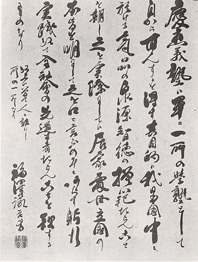
Today, our society is in an era of great changes. The Great East Japan Earthquake that occurred last year caused unprecedented damage to many areas, and also because of the accident at the nuclear power plant in Fukushima, many people still cannot return to their hometowns. Along with the expression “unexpected” that was used to describe the earthquake, tsunami and accident, the fragility of our society has also been revealed, and many are growing to distrust the supremacy of science and technology. At the same time, there are many transnational problems that have to be solved on a global level, such as the global environment issue and financial crisis issue in Europe and other countries. These issues are too complex for a single academic field to tackle. Not only Japan, but the whole world is truly nearing a significant turning point.
When we ask ourselves what we can do as we face these significant changes, we should reconsider the phrase “paragon of intellect and morals” in the “Mission of Keio University” written by Yukichi Fukuzawa. “Intellect” is the ability to recognize and evaluate things, and “morals” are the character and heart to care for others with selflessness. In order to be acknowledged as a “paragon of intellect and morals”, it is necessary to earnestly pursue the studies of jitsugaku, or empirical science, which Yukichi Fukuzawa often spoke of. At the same time, it is the mission of Keio University to nurture those who would become a “paragon of intellect and morals” and to contribute to society.
In this edition, we would like to introduce approaches taken by Keio University students as well as the position and vision of Keio University regarding learning, intellect, and morals through the following four episodes: study abroad, graduation research, seeking employment, and Keio’s Correspondence Courses (lifelong learning).
<Case 1 Study Abroad> Going abroad to pursue one’s studies
Both Japanese and French BA can be obtained within a minimum of 4 years of study.
The Faculty of Economics signed the first bachelor Double Degree Program among the faculties of Keio University, and has sent the first 5 Keio students to the Institut d’Etudes Politiques de Paris (Sciences Po) this summer. During the program, students deepen expertise in their field while receiving a liberal arts education, and can obtain a bachelor’s degree at both institutions in 4 years at the earliest. We interviewed one of the students participating in the program in July, just before his journey to France.
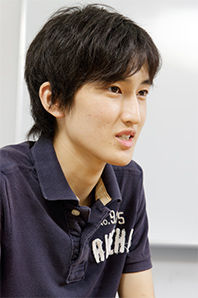
Second-year Student, Faculty of Economics

-How did you first find out about the double degree program?
After the summer inter-high school fencing championship had finished in the fall of my third year at Keio Senior High School, I was looking for something new to work on. That was when I learned about the program at the information session of the Faculty of Economics, and I strongly felt the desire to participate in the program.
I have never had experience living in a foreign country or studying abroad, nor was I ever exceptionally good at foreign languages. However, after learning about the program, I made up my mind to study English. At the same time, I craved for more academic knowledge, and I started to read a lot of books, such as Descartes’s philosophy and Porter’s management theory. I was excited that my world was expanding, and after entering university, I was able to feel my interest towards studying deepen even more as I learned about various fields through lectures and other opportunities. When I applied for the program, I communicated my desire to learn more.
-What is the appeal of this program?
That I can enter both Keio University and Sciences Po and spend time studying at both institutions. It is also appealing that I can have an identity as a student at both institutions. Students from all over the world gather at the Le Havre campus of Asian and European studies. There are less than 100 students in each year, and there are only about 20 students in classes for discussions and presentations. Hence, there will be more opportunities to express my opinions, and I will be doing a lot of reading. It is inspiring to be able to exchange opinions with those from different backgrounds, and I think it is really meaningful to study about Asia in Europe, and to be able to objectively view Japan and Asia, the country and region to which I belong.
-Please tell us about your plan from now on.
From September 2014, I will return to Keio with Sciences Po students for specialized study in economics. I still haven’t made up my mind about my future, but I believe that if I pursue what excites me while gaining a lot of inspiration from others, it will lead to my future path.
Hoping that students benefit from a host of stimulation and inspiration
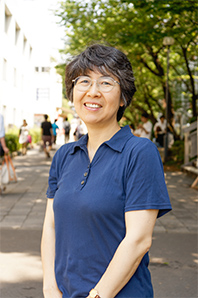
The purpose of the double degree program with Sciences Po is to nurture leaders of the next generation with an international mindset, general knowledge, and expertise in economics. Students who participate in the program spend two years in France, improving communication skills and cultivating character by exchanging views and opinions with students from various countries. The first round of students consists of 3 first-year students and 2 second-year students. I hope they will learn in the spirit of absorbing everything they can.
<Case 2 Graduation Research> Quantification of ambiguity
Image analysis study of pitching forms
Mr. Koji Fukutani can throw a fastball with a maximum speed of 155kph, and is an ace of the Keio University baseball team. He has contributed to two championship victories in the Tokyo Big6 Baseball League, and at the same time, has been diligently attending classes and working on experiments on a daily basis as a student of the Faculty of Science and Technology. Starting his fourth year, he has belonged to the laboratory of Associate Professor Yoshimitsu Aoki, and has started his graduation research. In this interview, we will dig into the relationship between sports and jitsugaku, or empirical science, from the dialogue between Mr. Fukutani, who chose baseball, a sport he has played for many years, as his research subject, and Assoc. Prof. Aoki, who offers Mr. Fukutani guidance.
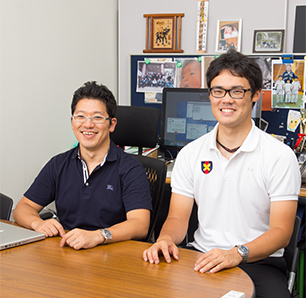
Aoki In the Faculty of Science and Technology, not many students seem to belong to the Keio University Athletic Association. How did you end up in my laboratory after entering Keio University?
Fukutani Actually, when I finished playing baseball in high school, I had no serious intentions to continue baseball at university. However, after having had the opportunity to watch the Keio baseball team practice, I liked how such a strong team had a positive atmosphere. That is when I decided to take the AO (Admissions Office) exams for the Faculty of Science and Technology. At that time, I wasn’t sure if I would be able to become a leading player; I wanted to become a science teacher, so I was planning to take classes to obtain a teacher’s license. But in my second year, I got to pitch in more and more games, and in the fall championship, I surprisingly received the honor of being selected as one of the best nine players of the Tokyo Big6 Baseball League. From around that time, I started to seriously consider becoming a professional player. As for my studies, there were times when I couldn’t concentrate on studying because of the difficulty maintaining a balance between studying and baseball, and because the fundamental courses and specialized courses on science and technology were all about theory. My feelings changed during my third year, when I created software using a web camera in Assoc. Prof. Aoki’s experiment class named “Laboratories in Electronics and Electrical Engineering”. I learned the excitement of creating things and wanted to join his lab.
Aoki Normally in laboratories of the Faculty of Science and Technology, students spend three years working on a research theme, using their fourth year of the undergraduate program and two years in graduate school, but Mr. Fukutani only had one year, so we struggled trying to find an appropriate research theme. Having considered its social practicality, we finally decided on research that takes an image analysis approach on pitching forms that deliver balls which are difficult for batters to hit.
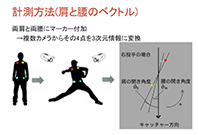
Fukutani Often on TV, a baseball commentator would say that a certain pitcher throws balls that are difficult to hit because it is hard to detect where the ball comes from. However, though this difficulty may be explained in words, pitching forms have never been quantified. The objective of my research is to quantify the movement of pitching using image analysis technology, and for that, we marked different parts of the body and videotaped the pitcher’s movements. With only one year of research, I may not be able to achieve a level high enough to present sufficient results, but I think I will be able to prove the hypothesis that I have formed while playing baseball. I am now working on my research, receiving advice from my professor and senior students.
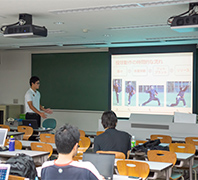
Aoki I used to play rugby when I was a student, and nowadays I practice judo. There are many ambiguous expressions in sports, but in order to win, a definite theory is indispensable, and quantification to back up the theory is also important. Mr. Fukutani has the passion of a pitcher, and, at the same time, the cool-headed perspective of a researcher, so I think this will be important for his further growth in the future.
Fukutani I think that my baseball career will benefit not only from physical activity, but also from always trying to improve myself with the spirit of inquiry that I learned at Keio University. I also think that this spirit will be an advantage after I retire as a player and when I get involved in teaching baseball. I might even return to Keio University decades from now to resume my research on image analysis of pitching forms (laughs).
